
by | Dec 9, 2014 | Consistency, Metabolism Reset, Strength Training, Testimonials
 The Two Year Plan
The Two Year Plan
Hi. I’m Liane and I’m one year into a plan. I was never good at the small details but great at the big picture. This is why I came up with a two year plan but ended up flying by the seat of my pants and still, to some extent, am. But let me start at the beginning (see, flying by seat of pants).
When I was in high school, I was a serious athlete. I played three seasons of sport (field hockey, basketball and softball) and had the body that went with this. In the 80s, the muscular with some body fat body wasn’t something to have as a teen (then again, it seems to never have been the body to have). I thought my butt was too large, my tummy too large and I hated my muscular calves. I wanted my best friend’s tall lithe body. I look back on those pictures and wish I had that body again! I was so cute and fit (my tummy was just lightly rounded but I couldn’t see it). BUT, I didn’t diet. It wasn’t big in my group of friends who all seemed to just eat.
The summer after I graduated I went and worked as a pool-side cocktail waitress in a bathing suit at a resort. Talk about horrible. I was a late bloomer and working with these college women who were much more developed. At the same time I started drinking alcohol and eating to deal with the emotions I was feeling, being away from home. I gained 20 lbs in that summer. Yup, the freshmen 15+ before even becoming a university freshmen. Ugh. I began to play Division 1 field hockey at university and along with eating less meat and more veg, I lost the entire 20 lbs during that year. I felt good about myself. I hadn’t starved myself but cut out a few small things. And then my sophomore year came and a new coach. She made us all get our body fat taken by caliper. I was told that at 22%, I would have to lose a lot of weight – I was fat. Yup, not just asking me to eat a bit less to get a lower body fat percentage but that I was fat and to lose weight. All my insecurities came back. And so I began to starve myself. I probably ate between 800-1000 calories most days, though more on weekends. As you can imagine, in the next three years I did lose a lot of weight but my hockey performance declined a lot. My coach had ruined me. But I was skinny.
 Throughout my 20s, I was constantly trying to keep that very skinny body shape. I would under eat, workout for hours and smoke. Yuck. But I was skinny for the most part.
Throughout my 20s, I was constantly trying to keep that very skinny body shape. I would under eat, workout for hours and smoke. Yuck. But I was skinny for the most part.
When I wasn’t doing these things, my weight would balloon. And as I got older it got harder to go between heavier and skinnier. The worst was when I ended up tearing my ACL while playing rugby. I couldn’t exercise for months in the same way and I ate because I was unhappy. So I gained again.
Up, down, up down, never actually learning how to eat the right way. But I kept around a decent body weight and I doubt anyone would have ever called me ‘fat’ (though I felt that way). In 2004, I moved to London for a job. In the first few months, I lost weight despite drinking lots of beer with my new field hockey teammates and felt fantastic at my dad and stepmom’s wedding. I didn’t really eat a lot because I was a bit broke and I was walking everywhere as the transportation was expensive (and I didn’t have a paycheck right away). I then met my to be husband. He is a born and bred Londoner. And he loves food. He was the first guy I met who told me to eat more, that I was too skinny and that he couldn’t understand women who ate salads only. He loved my bum and hoped that I would get curvier.
 That led to the two of us sharing our love of food and cooking. He taught me Indian dishes (as that was his background) and I showed him how to barbecue. Over the next couple of years, we both slowly gained weight, though I did more so due to eating his size portions. I called it my boyfriend weight. But I was happy. I didn’t even care about losing weight before I got married though I was sad to have a tummy in my wedding pics (Indian style wedding so tummy showed!) Eventually, I actually weighed myself and saw that I was 170 lbs. Holy cow. This was by far the heaviest I had been at 5’6″. I found MFP and lost 20 lbs quite quickly (I put myself in for a 2 lb a week weight loss). I ate very little, which felt natural to me. A few years later (and a year ago), I saw pics of myself looking quite fat faced and decided to weight myself. 165. Darn it. Gained weight again! Back to MFP where I quickly lost 5 lbs.
That led to the two of us sharing our love of food and cooking. He taught me Indian dishes (as that was his background) and I showed him how to barbecue. Over the next couple of years, we both slowly gained weight, though I did more so due to eating his size portions. I called it my boyfriend weight. But I was happy. I didn’t even care about losing weight before I got married though I was sad to have a tummy in my wedding pics (Indian style wedding so tummy showed!) Eventually, I actually weighed myself and saw that I was 170 lbs. Holy cow. This was by far the heaviest I had been at 5’6″. I found MFP and lost 20 lbs quite quickly (I put myself in for a 2 lb a week weight loss). I ate very little, which felt natural to me. A few years later (and a year ago), I saw pics of myself looking quite fat faced and decided to weight myself. 165. Darn it. Gained weight again! Back to MFP where I quickly lost 5 lbs.
But then I began to read more in the forums. Some women were posting about eating more, especially as they didn’t have a lot of weight to lose, which I didn’t. I wanted to get to 145 minimally, so I went with 1 lb a week. Lost some weight and then went to 1/2 lb weight loss goals. I was doing some weight lifting on the machines which made me feel like I was getting a bit stronger. My input of calories slowly went up to 1900. And then I just stayed there. It was frustrating. I wasn’t really losing a lot of weight, but the ladies I friended encouraged me to read more and take my time. I eventually got to the EM2WL group on MFP and it was there that I finally figured out how to do this. I didn’t want to lose weight only to gain it again. I was 45, darn it, and I wanted to start eating for my lifestyle while also losing some body fat.
 I joined the website forums and began to post. I started doing Stronglifts 5×5 as it seemed like a great programme. I lost those final few pounds to get to 145 as I was eating more (who knew?) and I decided that I would try to figure out my true TDEE so I could do a healthy cut to get to my final goal weight of 140.
I joined the website forums and began to post. I started doing Stronglifts 5×5 as it seemed like a great programme. I lost those final few pounds to get to 145 as I was eating more (who knew?) and I decided that I would try to figure out my true TDEE so I could do a healthy cut to get to my final goal weight of 140.
I’m still in the midst of doing this. I’ve slowly added 100-200 calories and held at that level for a month at a time. I’ve had setbacks such as breaking a rib and getting a major chest infection which has influenced how much and what I could do as workouts. But I’ve held strong. I’m now eating the way I hope to for life – I haven’t given up a single food but I’m trying to keep my protein intake a bit higher (to keep my muscles) and watch my portion size. Amazingly enough, I’m eating almost at dinner some nights what I used to eat all day (around 1200 calories). I’m still in the midst of figuring out my TDEE (I’m at 2400 calories currently) and once I get to the point where I am gaining weight steadily, then I’ll know it’s time for a small cut of 10-15%.
I’m one year into my two year plan. I didn’t know how to get to where I was going, but now, I have more of an idea of what I need to do. I’m no longer really listening to the scale in the same way I used to. For me, it’s a tool to figure out my TDEE but not to figure out if my body is where it needs to be. I’m using measurements and my mirror as my guides. I’ll never been a fitness model, nor do I want to be one, so I’ll always carry a bit more body fat than others. I want to be able to have pizza and beer while still feeling fit. I want to still be playing field hockey at age 50 (I’m almost 46 and going strong on a team in London). And, if I live to my 90s like my grandmothers did, I want to be in the best health that I can, with strong bones from lifting and eating well. Yeah, those are good goals.

by | Nov 11, 2014 | Building Muscle, Consistency, Fat Loss / Cutting, Metabolism Reset, Testimonials
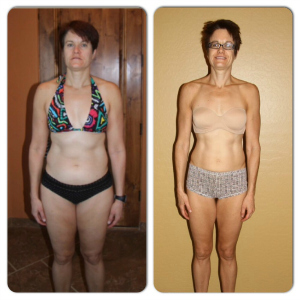 Kiki has been bugging me for a while now to write about my weight loss and fitness journey, so here I am finally getting the courage up to writing it. I say courage because in the past year I have come to realize quite a few things about myself that I was ashamed about for a long time and have finally come to be able to face the truth. Yes, I too (as many women do), suffer from binge eating disorder (BED), but let me start at the beginning of my journey, because I couldn’t always admit, or understood that this was going on.
Kiki has been bugging me for a while now to write about my weight loss and fitness journey, so here I am finally getting the courage up to writing it. I say courage because in the past year I have come to realize quite a few things about myself that I was ashamed about for a long time and have finally come to be able to face the truth. Yes, I too (as many women do), suffer from binge eating disorder (BED), but let me start at the beginning of my journey, because I couldn’t always admit, or understood that this was going on.
Upon turning 40 (4.5 years ago), I was very unhappy with my body and weight and the fact that hiking was getting hard for me. I live in Arizona and hiking is one of my husband and my passions, especially at the Grand Canyon. Well, it was a trip to the canyon that finally snapped me into reality and made me make the decision to do something about my weight that had ballooned to 185. I am 5’7” and 195 was the highest weight that I had gotten to in the past, so I was closing in on that number again! I decided to give online weight watchers a try and had (what I thought) was great success, after all I dropped 45 pounds in about 4 months! Of course, I quickly hit a plateau and continued to increase my exercise, while sticking to the very low “points” that weight watchers was allowing me; rarely to never eating back my exercise calories that continued to increase with my cardio/calorie burn obsession!
 After about a year of weight watchers, I decided not to renew my contract and to switch over to MFP, where I discovered that there was a whole group of Cathe Friedrich obsessed women out there. For those of you unfamiliar with Cathe, she is a workout DVD genius and my guru! I had been lifting weights with her DVD’s along with her cardio DVD’s during the whole weight watchers process. It was a breath of fresh air to meet all of these women with the same workout commitment that I had. Well, long story short, I got hooked up with Kiki through other mutual Cathe/MFP ladies and started to read her blog posts and watched her YouTube videos. This is where I first got hooked up with EM2WL and started to realize that the health industry has steered us women in the wrong direction when it comes to “losing” weight.
After about a year of weight watchers, I decided not to renew my contract and to switch over to MFP, where I discovered that there was a whole group of Cathe Friedrich obsessed women out there. For those of you unfamiliar with Cathe, she is a workout DVD genius and my guru! I had been lifting weights with her DVD’s along with her cardio DVD’s during the whole weight watchers process. It was a breath of fresh air to meet all of these women with the same workout commitment that I had. Well, long story short, I got hooked up with Kiki through other mutual Cathe/MFP ladies and started to read her blog posts and watched her YouTube videos. This is where I first got hooked up with EM2WL and started to realize that the health industry has steered us women in the wrong direction when it comes to “losing” weight.
After many conversations with Kiki, I was convinced and finally understood that eating really low restricted calories was always going to set someone up for failure, especially when it comes to losing weight and keeping it off and that the healthiest route was to eat to fuel your body and to lift weights, heavy weights! As I mentioned, I had been lifting weights all this time, but never understood why I was never able to make any progress in muscle development and that I had actually lost much of my muscle. Oh, and I should mention that during this plateau, I didn’t understand why every time I would feel like I made some progress I would fall into a binge tailspin. For 9 months, it was 2 steps forward and 1 huge binge step back. Every time this would happen I would absolutely loath myself and shame myself etc, but never understanding that it was partly my body’s way of telling me to “feed me”! (Of course there are also psychological reasons for the binging as well).
I finally let her convince me to do a metabolism reset after being at the plateau for a good 9-12 months and losing and gaining the same 5#. Silly me, I thought that I would reset my metabolism for 6 weeks and then start cutting again. I didn’t understand why after that 6 weeks I had gained a good 10# back and why when I started cutting it didn’t just fall right off!? After more conversations with Kiki and more research, she finally got me to understand that it wasn’t a number that I could assign to my reset, that it could and would take time, quite possibly a LONG time. She also convinced me to join a group of ladies who were starting STS (a 3-6 month Cathe weight lifting program), while bulking (eating above calorie requirement). She did warn me that I would gain weight and boy did I. I gained about 20# back, bringing me back to around 160. I was a little scared, as was my husband starting this process but new it was going to be for my good. After STS was finished I decided to try a cut. I lost some of that weight, but I could tell that my metabolism still wasn’t healed, so I started to eat at what I thought was maintenance and stayed there for a long time.
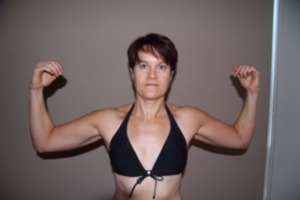 I should mention, that after I lost all the weight with weight watchers, I told my husband that I thought I wanted to someday compete in a figure competition. I had an unwritten goal of competing before I was 45. Well, I talked about this goal for about 4 years and finally, a (very devout Christian) friend of mine finally pointed out that maybe the fact that I kept bringing this topic up every few months, that maybe, just maybe God was directing me to actually go for my goal. I should mention that within all this time of weight loss and resets, I was born again (which is why she felt it was God calling me to this goal, for whatever reason). We both figured the reason was not because he wanted me to compete, but one much more deeply.
I should mention, that after I lost all the weight with weight watchers, I told my husband that I thought I wanted to someday compete in a figure competition. I had an unwritten goal of competing before I was 45. Well, I talked about this goal for about 4 years and finally, a (very devout Christian) friend of mine finally pointed out that maybe the fact that I kept bringing this topic up every few months, that maybe, just maybe God was directing me to actually go for my goal. I should mention that within all this time of weight loss and resets, I was born again (which is why she felt it was God calling me to this goal, for whatever reason). We both figured the reason was not because he wanted me to compete, but one much more deeply.
This conversation occurred in December of 2013 and around the same time, my husband got fed up with my talk and said that I needed to just do it! After much discussion with him and other women who had competed and a TON of prayer, God led me to an online trainer who came highly recommended and who was also a Christian. I signed a yearlong contract that began on January 27 2014 that included a nutrition and training plan, with the intention of competing on November 1, 2014. You are probably wondering how did it go!? It didn’t.
After starting with my trainer, I quickly started seeing results, not only in fat loss, but overall improvement in my cardio ability as well as muscle development. I couldn’t and still can’t believe the amount of muscle that I have been able to develop. So why did I not compete? As I said, I felt God had me on this journey for a much bigger reason than simply competing and as it turned out, it has been a journey of healing and learning about nutrition and coming to a place where I can finally admit that I do suffer from BED. Do I still struggle with BED? Constantly! Have I binged during this new goal phase of my life? Sadly yes, but with God’s help I am working on it and have only had 2 major occurrences in the last 9 months, which is a great improvement from binging every few weeks.
 So, the reason I didn’t compete? Twelve weeks out from the competition date, when true contest prep would normally take place, I got a response from my trainer that I was not expecting. She felt that with my BED issues, that she could not get me to competition readiness without restricting my calories too much and with my ED, she knew it was the wrong thing to do. After much discussion with my husband, we both agreed that this is why I hired her and I should heed her advice.
So, the reason I didn’t compete? Twelve weeks out from the competition date, when true contest prep would normally take place, I got a response from my trainer that I was not expecting. She felt that with my BED issues, that she could not get me to competition readiness without restricting my calories too much and with my ED, she knew it was the wrong thing to do. After much discussion with my husband, we both agreed that this is why I hired her and I should heed her advice.
We have now moved into a muscle building phase and the new goal is to compete in spring of 2015 and if I am still not ready, than winter 2015. Needless to say, I now know this is a journey of not only physical health, but mental and spiritual as well and I will take as long as I need to get to the point of competing. My mindset has changed from “I just want to be able to say that I did it”, to “I did it and I won!”
I guess I should add my stats for those of you who are wondering (I started tracking in July of 2012 and unfortunately don’t have pictures for the earlier dates):
July 2012: 158 (end of my second reset)
September 2012 (the start of STS and after a short cut): 152
March 2013 (end of my first official bulk): 164
June 2013 (end of my first cut): 150
December 2013 (during my second bulk): 154
January 27, 2014 (the start of my figure training) 25% bf and 154.5
August 11, 2014 (12 weeks out from competition) 18.8% bf and 134
October 27, 2014 (last check in with my trainer) 17.7% bf and 132
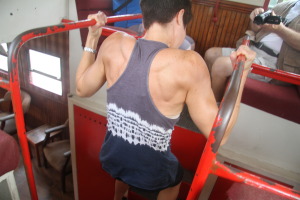
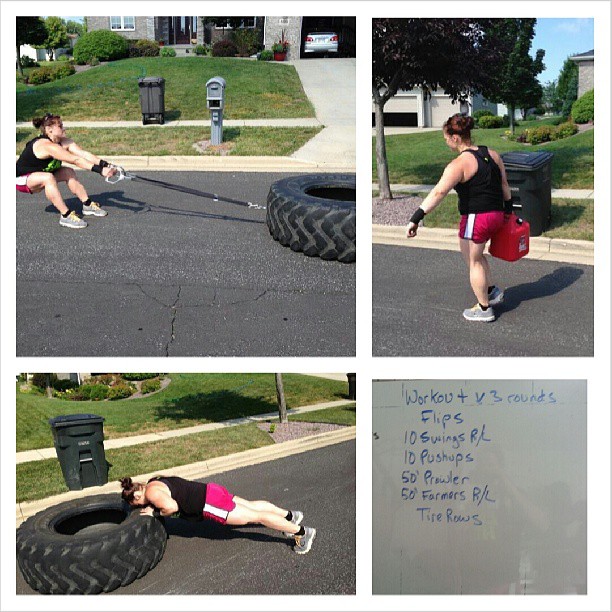
by | Oct 29, 2014 | Building Muscle, Cardio, Fat Loss / Cutting, Motivation, Nutrition
 With the ever-increasing popularity of intense workout programs like CrossFit, metabolic conditioning, or metabolic resistance training (MRT) seems to be a fitness trend that’s here to stay.
With the ever-increasing popularity of intense workout programs like CrossFit, metabolic conditioning, or metabolic resistance training (MRT) seems to be a fitness trend that’s here to stay.
These workouts tend to be intense, impressive, and very cool-looking. Typically, they have the added benefit of giving you a goal to work towards (beat the clock!). Who doesn’t want to flip a big heavy tire, beat things with hammers, and carry around heavy weighted objects as fast as possible?
If you’ve done your part, by the end of the workout, you’re exhausted, sweating from head to toe, and sprawled out on the ground, hoping someone will bring you a protein shake (or maybe a gallon of Ben and Jerry’s…).
Obviously you’ve just had a great strength training workout, right?
Not necessarily.
What is Metabolic Resistance Training?
It can be confusing to understand exactly what this term means since this term is thrown around pretty haphazardly in the fitness world. It is not just a bunch of random exercises done as quickly as possible.
Simply put, Metabolic Resistance Training is a form of metabolic conditioning. The purpose of metabolic conditioning is to increase the efficiency of one of the three pathways used in exercise metabolism. Metabolic conditioning has the added benefit of conditioning the muscles to better use to fuel delivered to them. Ultimately, this should result in a better capacity to burn fat.
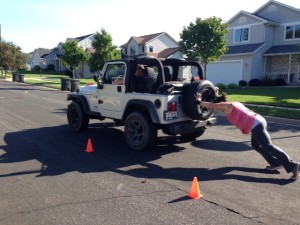
I do love pushing vehicles as a supplement to my serious strength training workouts!
Metabolic conditioning can be a great tool if your goal is fat loss. Not only does metabolic conditioning burn tons of calories during a workout, it also increases caloric burn in the 24-48 hours after your workout. This is due to excessive post-exercise oxygen consumption (EPOC). There are various different types of work to rest periods intended to increase EPOC.
A few examples are:
Tabata: 20 seconds of hard work, followed by 10 seconds of rest for 8 total rounds
30 On/30 Off: 30 seconds of hard work, followed by 30 seconds of rest for 6 total rounds
Circuits: Perform 3-6 exercises in a row with minimal to no rest between sets. These exercises should follow a logical pattern and should include elements of pushing, pulling, squatting, hinging, and carrying objects.
Energy Systems – The Goal of MRT
The primary goal of metabolic conditioning is to increase the efficiency of one of three metabolic pathways used in energy metabolism.
Creatine Phosphate Pathway: Also referred to as the Immediate Pathway, this energy system is responsible for providing short (less than 10 seconds) bursts of energy. This is the energy pathway utilized when performing quick power exercises like Olympic or powerlifting-style lifts or sprinting. It takes this energy system about three to five minutes to recover to its fullest potential.
Glycolytic Pathway: Also referred to as the Intermediate Pathway, this energy system provides the energy required for short, intense activities lasting one to four minutes. If you are completing high-intensity cardio intervals or doing multiple reps of a particular exercise, this is the pathway being utilized. It takes this energy system about 1-3 minutes to fully recover.
Aerobic Pathway: Also referred to as the Long-Duration Pathway, this metabolic pathway provides the energy required for longer-duration exercises of moderate-intensity work. This energy system can provide energy for hours of activity, since it has a limitless reserve (fat) to draw upon.
The energy system being conditioned by these workouts is largely determined on the rest period between sets. When structuring a metabolic resistance training circuit, it is important to keep the end goal in mind! The goal is NOT to throw weights around as fast as possible! These workouts should be well structured in order to maximize results.
It is important to remember that regardless of the activity performed, there is always some crossover between energy systems.

Metabolic conditioning is a fun way to get some cardio in, but nothing beats strength!
Is MRT the Same as Strength Training?
MRT typically involves weighted objects such as tires, battle ropes, farmer’s walks, sandbags, and kettlebells. These weighted objects are lifted in rapid succession, and the intensity is kept very high.
However, it is important to remember that the main goal of these workouts is not to maximize strength and to build muscle. The main goal of these workouts is to better utilize energy stored in the body. The primary goal of these workouts is more maintaining strength levels than gaining strength and adding muscle mass.
It’s key to remember that metabolic conditioning is not meant to be a haphazard, random bunch of exercises thrown together with the goal of burning a bazillion calories. These types of workouts are an advanced technique. So advanced in fact, that they are what many elite athletes turn to when they have reached their potential and are simply trying to maintain their current level of fitness. For the average recreational exerciser, it is important to complete these workouts under the supervision of a skilled trainer or strength coach.
The bottom line? You should view MRT workouts as a highly effective form of cardio, along the same lines as HIIT, meant to burn fat. These workouts are not intended to replace conventional strength training.
Is MRT right for you?
MRT can be a fantastic tool in your fat loss arsenal, provided that all other key elements are on pointe.
 Alwyn Cosgrove, author of the best-selling series New Rules of Lifting, who has a great reputation for results-driven fitness, has come up with a Hierarchy of Fat Loss that can serve as a great checklist to go through when evaluating whether and how new training philosophies will help you reach your goals. You should think about approaching the following elements in order. As long as you are achieving the results you desire, even if progress is slow, there is no reason to add elements further down the list. Stay patient and trust the process!
Alwyn Cosgrove, author of the best-selling series New Rules of Lifting, who has a great reputation for results-driven fitness, has come up with a Hierarchy of Fat Loss that can serve as a great checklist to go through when evaluating whether and how new training philosophies will help you reach your goals. You should think about approaching the following elements in order. As long as you are achieving the results you desire, even if progress is slow, there is no reason to add elements further down the list. Stay patient and trust the process!
1. Nutrition If your ultimate goal is to lose fat and increase lean muscle mass, start with nutrition. Keep it simple, and don’t overthink things. Your first step is to make sure that you are eating enough calories to support a healthy metabolism and maintain your lean muscle mass while you are losing fat. The more muscle you have, the higher your metabolism, so don’t sacrifice your lean mass for a smaller number on the scale! After you have made sure that you are taking in a sufficient amount of calories, look at your protein. A great goal is to take in approximately 1 gram of protein per pound of body weight. Take in plenty of healthy fats, and round everything out with some carbohydrates.
2. Nutrition Yes, it’s that important! Until you get your nutrition on pointe, there’s no point in prioritizing anything else! Activities that burn calories, maintain and promote muscle mass, and elevate metabolism Our metabolism is largely determined by our resting metabolic rate (RMR). RMR largely depends on how much metabolically active tissue (AKA muscle!!!) you have. Therefore, activities that increase RMR by maintaining or gaining muscle mass should be of next importance. A solid, periodized strength training program utilizing heavy weights with well-managed rest periods will accomplish this goal. Your strength training program should include plenty of compound movements like the squat, pull, push, lunge and hinge. Depending on your split, you should be lifting heavy weights 2-4 times per week. Bonus points here if your strength training program uses percentages of 1RM to determine your training loads! Circuit training, high-rep, low weight workouts, and metabolic conditioning do not fall into this category. Some of our favorite recommendations for a solid strength training program include STS, Stronglifts, and New Rules of Lifting for Women.
3. Adding in activities that burn calories and elevate metabolism. This is where activities falling under the realm of metabolic conditioning come in. Metabolic resistance training, HIIT, circuit training, and tabata training are powerful fat loss tools. They are far superior for producing results than traditional, steady-state cardio. If you have your nutrition on pointe, are killing your strength training workouts, and not seeing the results you desire, you may wish to experiment by adding in 1-2 short metabolic conditioning workouts each week. These are meant to supplement, NOT replace your strength training program. These workouts are very taxing and intense, and you may find that by adding them in, your appetite goes soaring through the roof! Make sure that you are continuing to fuel these workouts and getting plenty of recovery time. Adding a short metabolic finisher to the end of your workout might be a better option if you are new to this type of training or are short on time.
4. Activities that burn calories but don’t necessarily maintain muscle or elevate metabolism. If you still have additional time to devote to your training, you might consider adding in a steady-state cardio workout. These workouts will burn calories, but do not put you at any significant metabolic advantage. You should be aware that these types of activities can work against you if your goal is to build or even maintain your current muscle mass. Therefore, steady state cardio should be included as a last resort, only if you are making sure that these activities do not put you in too large of a caloric deficit, and only if you truly enjoy these types of activities.
 Becca is a busy wife and homeschooling mother to five children ages 5 to 13. About three years ago, she embarked on a journey to health and fitness that resulted in the loss of approximately 100 pounds. Today, she is a competitive powerlifter and strongwoman who loves ice cream and deadlifts. As an ISSA certified personal trainer, she is passionate about helping women to get started on a lifestyle of strength and fitness.
Becca is a busy wife and homeschooling mother to five children ages 5 to 13. About three years ago, she embarked on a journey to health and fitness that resulted in the loss of approximately 100 pounds. Today, she is a competitive powerlifter and strongwoman who loves ice cream and deadlifts. As an ISSA certified personal trainer, she is passionate about helping women to get started on a lifestyle of strength and fitness.
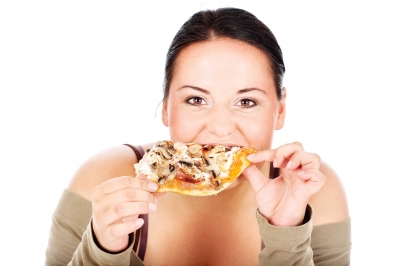
by | Oct 27, 2014 | Fat Loss / Cutting, Nutrition
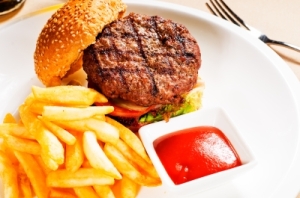 In the past when we thought of fast foods restaurants — like McDonald’s or Burger King — a picture of greasy fries, burgers, and sugary sodas came to mind. We imagined a line of cars at the drive-thru waiting patiently to receive grease stained bags, passed through the window from a lady with a headset. Nowadays we see commercials of a gorgeous skinny girl holding a burger that’s bigger than her head, piled with beef, cheese, onions, bacon, lettuce, bacon, tomatoes and more bacon that she barely takes a bite of. I’m usually thinking, “ugh what a waste of good protein!” (And, how come those burgers never look like that in real life?! Hmm?) Yes, I’ve had one of those burgers, and it tasted pretty good! Then afterward…I checked the restaurant’s website for the nutritional content, and discovered I ate half of my calories in one meal. (Thank goodness I eat more than 1200 calories…but that’s a completely different blog!)
In the past when we thought of fast foods restaurants — like McDonald’s or Burger King — a picture of greasy fries, burgers, and sugary sodas came to mind. We imagined a line of cars at the drive-thru waiting patiently to receive grease stained bags, passed through the window from a lady with a headset. Nowadays we see commercials of a gorgeous skinny girl holding a burger that’s bigger than her head, piled with beef, cheese, onions, bacon, lettuce, bacon, tomatoes and more bacon that she barely takes a bite of. I’m usually thinking, “ugh what a waste of good protein!” (And, how come those burgers never look like that in real life?! Hmm?) Yes, I’ve had one of those burgers, and it tasted pretty good! Then afterward…I checked the restaurant’s website for the nutritional content, and discovered I ate half of my calories in one meal. (Thank goodness I eat more than 1200 calories…but that’s a completely different blog!)
Although this burger may be OK every so often, we know that we should not eat like this every day, yet we don’t always have the time to cook up a healthy meal. If cooking a meal doesn’t fit into your schedule on some occasions, there are some healthy alternatives that most fast food restaurants including McDonald’s, Burger King, and Wendy’s now offer. You just have to do your homework and know what you are going to order before you get there. 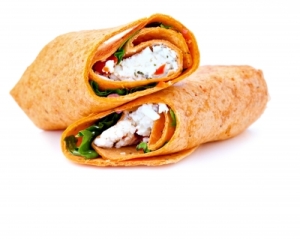
Quiz time! So of these two meals from McDonald’s, which would you order if you are watching your macros, but also wanting a healthy protein packed meal; a small regular cheese burger with an order of small fries or a grilled McWrap with chicken and bacon with and order of small fries? If you picked the grilled chicken and bacon McWrap, you would have picked the one with the higher calorie and fat content. The cheeseburger and fries are 520 calories, 22g of fat, 17g of protein and the wrap is 710 calories, 30g of fat but it has 38g of protein. So if you could remove the mayonnaise from the wrap and replace it with mustard you may have a winner! On the small burger if you remove the cheese you will do even better. But, who wants a cheeseburger without cheese? Not me.
So, if you’re counting calories and your macronutrients, just be careful of the condiments and toppings that you add to your sandwiches. Most restaurants will make the sandwich your way with the condiments you want. Just remember to check it out before you leave to ensure it has been prepared correctly. At sandwich or sub shops like Subway or Jimmy John’s, it’s basically the same scenario that condiments will make the difference. Mayonnaise and cheese aren’t bad, you just have to fit them into your calorie and macronutrient budget.

I recently found out that a very popular Cajun fried chicken restaurant called Popeye’s has blackened chicken tenders. I tried them and they were very tasty. For 3 it was 170 calories and 2 grams of fat and 26g of protein. The same breaded and fried were 310 calories, 15g of fat and 28g of protein. Now if you are also monitoring your sodium and cholesterol, you must take that into account with ALL fast foods. Most are ridiculously high in both. Google foods and check that nutrition information as they may push you above your intake goal.
Many people like to choose salads at fast food restaurants thinking this is the best choice. Did you know that you could take a perfectly healthy salad and add a lot of calories and fat to it by over doing it with dressings, croutons and cheeses? Ingredients that are not being weighed or measured as you’re adding them to your plate, typically have calories that add up fast. In the end, you would have been better off getting the grilled chicken with veggies, mustard and fries.
If fast food restaurants aren’t for you, there are plenty of grocery stores that now have hot delicatessens where they prepare grilled chicken with fairly healthy side dishes like green beans, mixed vegetables and mashed potatoes. (Yes, don’t forget the carbohydrates) All you do is take it home, light some candles, and you have an “almost” home cooked meal.
Of course, the best option is to plan and have great home cooked meal, but we all know life happens and you might not be able to do this sometimes. Just remember, there are plenty of delicious alternatives that you can choose from when you’re in a pinch. With all the different options and choices most fast food restaurants are offering, you will never have to skip a meal or settle for an unhealthy substitute, unless you want to.
Nutritional information for popular fast-food restaurants:
McDonald’s
Popeye’s
Burger King
Wendy’s
Chick-fil-a
Photo credit:
Serge Bertasius Photography
KEKO64

by | Oct 7, 2014 | Consistency, Increasing calories, Motivation, Testimonials, Transformations
 Hey there!
Hey there!
My name is Jeannetta! I have no idea where to start my transformation story, and I can’t give exact times and dates. What I can tell you is that finding this group on MFP is the best thing that could have ever happened to me. So, I think I’ll start on the topic of MFP.
I’d done MFP haphazardly in my mid 20’s. I’d always had weight issues. At a very young age, I was considered chunky. I was always bigger than my peers. In retrospect, I ate horribly as a child and teenager. The truth is, I didn’t know any better. We ate plenty of junk. Canned foods, fried foods, refined carbs, you name it. I don’t remember a balance of foods. Everything I learned about food and proper eating habits came to me in my early 20’s. At that point in time, I came home from college tipping the scales way over 200 lbs and about a size 22. I had horrible acne. I couldn’t fit into the latest fashions. I was fat, and I was over it.
When I moved home (Chicago) two things changed. I walked a hundred percent more. I took public transpo everywhere. That meant walking to and from the bus/L stops, walking from those stops to wherever I was going. Then back around again. Running to those stops sometimes. I mean, to go up and down L stairs and ramps, just commuting I had to be climbing a minimum of 13 flights of stairs in a day. If I wanted to go to the corner store/ bar/ most restaurants, I walked.
 The second thing that changed were my eating habits. I was eating better and didn’t technically realize it until later. I had more variety in my diet because of our food culture in Chicago (fresh foods, etc). One year later, I weighed in out of curiosity one day. My pants were falling off. I’d lost 30 lbs. That’s when I made the connection between activity and food. Soon after the weigh in, I went and got a gym membership. I not only was doing my daily commute walking, I was doing an hour of interval sprints or the elliptical, and weights maybe twice a week. I’d also started dabbling with that 1200 calorie number on MFP. Cleanses, psyllium tablets, senna tablets, and green tea became a huge part of my diet. I ate but was very restrictive. I was one of those, I don’t eat this and that people, but in private would max a pint of Hagen Daz half the fat vanilla ice cream. I would then justify it by the all the activity, and all the chicken, salmon, broccoli, and sweet potatoes one would enjoy. I would feel guilty for eating out with my girls. When I look back, I had an ED like a mug. I’d lost 60+ pounds, but was obsessed with losing more and getting smaller.
The second thing that changed were my eating habits. I was eating better and didn’t technically realize it until later. I had more variety in my diet because of our food culture in Chicago (fresh foods, etc). One year later, I weighed in out of curiosity one day. My pants were falling off. I’d lost 30 lbs. That’s when I made the connection between activity and food. Soon after the weigh in, I went and got a gym membership. I not only was doing my daily commute walking, I was doing an hour of interval sprints or the elliptical, and weights maybe twice a week. I’d also started dabbling with that 1200 calorie number on MFP. Cleanses, psyllium tablets, senna tablets, and green tea became a huge part of my diet. I ate but was very restrictive. I was one of those, I don’t eat this and that people, but in private would max a pint of Hagen Daz half the fat vanilla ice cream. I would then justify it by the all the activity, and all the chicken, salmon, broccoli, and sweet potatoes one would enjoy. I would feel guilty for eating out with my girls. When I look back, I had an ED like a mug. I’d lost 60+ pounds, but was obsessed with losing more and getting smaller.
It became harder and harder to maintain. Even though I was doing all the “right” things. The moment I would take a break from working out, I swear 10 lbs would show up so quick!!!!! Even still, I maintained the weight loss, give or take the ten lbs, for almost four years. When I look back, my actions were crazy. I’d started eating more fresh foods, and less prepared/processed foods, which was great, but that all came with binges.

Here I am, covering myself with my children’s bodies.
Fast Forward.
I got pregnant, and had two babies between 2008 and 2010. Yeah I know, my lifestyle changed. I began driving everywhere because I didn’t want to be on public transpo with two kids under two. I ate when I could. I had very little time to work out. The weight piiiiiiled on. I cried and cried. I was miserable. I didn’t want to take pictures. I didn’t want to be intimate with my husband. I was tired all the time. Depressed. Ashamed. I became the mom who let herself go. I’d promised myself I’d never be overweight again, and there I was, fat and ashamed with no self-love —constantly feeling sorry for myself.
My husband, he got me right together one day. He said to me, “I love you no matter how big or small you are, but I am soooo tired of you crying about it. If you want to change it, I’ll take the kids to school so you can get up and work out”. I started working out at home in the basement with a friend of mine to a Beach Body program that was sooooo fun! I was burning like 7-800 cals a session. But, I was also following a 1200 calorie schedule. I wasn’t losing a lb! I did feel better cardiovascular wise, but I was Hangry and I wasn’t losing any weight! That was the day I decided to utilize MFP to its fullest potential. I was going to go through profiles, see who was the fittest in their pictures and friend them.
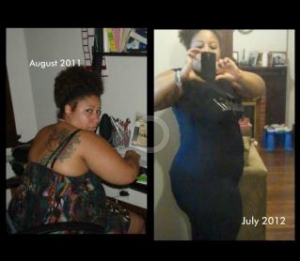 That’s how I found Lucia. Call it luck or whatever, but I really believe I found her by the grace and mercy of The Lord. I’d started down the supplement trail again. I was doing the BB shake, protein shakes, green tea extract, enzymes, etc! I really, I mean in my gut knew I was not supposed to be taking all this crap. I was desperate again. Upon stumbling on her profile, I remember admiring her gun show. I remember doing a double read of her “About Me”. I remember reading she ate over 2500 calories a day. I remember looking back at her picture and thinking WTF? She is LYING!!! I remember going to her diary and reading her log, and my mouth dropping open. I remember being confused. So I friended her, I started going through her friends list and noticing all the EM2WL peeps, and I went on to friend others. I remember sending her the most desperate message. All I remember from that reply was metabolism reset, and Scooby’s Calculator. That’s when the research began. I felt bamboozled. All these years of starvation and excess cardio???? Even though I thought these ideas were crazy, you know, like the idea of EATING. I done everything else crazy, so I took my cals up from 1200 to 2500 in one day. By the end of the week, I’d lost 9lbs. It wasn’t a great 2500 calories. I ate whatever I wanted for about six months. I leveled out at about a 15 lb loss over the next year and a half.
That’s how I found Lucia. Call it luck or whatever, but I really believe I found her by the grace and mercy of The Lord. I’d started down the supplement trail again. I was doing the BB shake, protein shakes, green tea extract, enzymes, etc! I really, I mean in my gut knew I was not supposed to be taking all this crap. I was desperate again. Upon stumbling on her profile, I remember admiring her gun show. I remember doing a double read of her “About Me”. I remember reading she ate over 2500 calories a day. I remember looking back at her picture and thinking WTF? She is LYING!!! I remember going to her diary and reading her log, and my mouth dropping open. I remember being confused. So I friended her, I started going through her friends list and noticing all the EM2WL peeps, and I went on to friend others. I remember sending her the most desperate message. All I remember from that reply was metabolism reset, and Scooby’s Calculator. That’s when the research began. I felt bamboozled. All these years of starvation and excess cardio???? Even though I thought these ideas were crazy, you know, like the idea of EATING. I done everything else crazy, so I took my cals up from 1200 to 2500 in one day. By the end of the week, I’d lost 9lbs. It wasn’t a great 2500 calories. I ate whatever I wanted for about six months. I leveled out at about a 15 lb loss over the next year and a half.
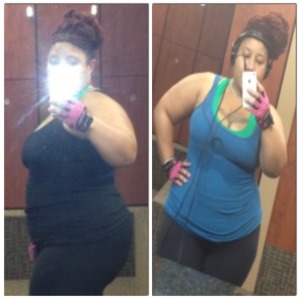 I was still doing a massive amount of cardio and very little lifting. I’d eased up on the supps. Our family moved to Georgia. I didn’t work for 6 months. I worked out an hour a day, but was sedentary the rest of the day. I was still eating 2500 or more cals, not making adjustments for my activity levels. I gained 30 lbs.
I was still doing a massive amount of cardio and very little lifting. I’d eased up on the supps. Our family moved to Georgia. I didn’t work for 6 months. I worked out an hour a day, but was sedentary the rest of the day. I was still eating 2500 or more cals, not making adjustments for my activity levels. I gained 30 lbs.
I followed a few other eating more groups and found that weight lifting, building your metabolism, moderation, and eating for your individual activity levels were all these groups had in common. By this time though, I’d started feeling really crummy. I was tired all the time, depressed/anxious, low libido, bloating, constipation, rapid stomach fat gain etc. I had a laundry list of things going on. I’d started cutting cals slowly, cutting some of my cardio and replacing with weight training like I’d learned from the groups, and eating moderately, but even still, I wasn’t losing, and I wasn’t physically feeling well. I went to the doctor. I found out I was insulin resistant. Yep, I was on my way to having diabetes. I sigh even typing this. I never thought I’d be here. I had a cry fest for a couple of days, mostly because my doctor prescribed me the Atkins or South Beach DIET. I was so over diets at this point. I’d been on a diet my whole adult life. I did not want to go on a DIET. I was tired of restricting. I was at a place where I’d started to accept my body for the way it was, and appreciate what it could do. And now, the doctor wants me to go on another restrictive diet. A diet I knew I would fail miserably at, again. I’d already been on both previously and hated every minute of it.
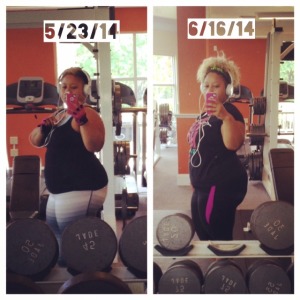 But I’m a resourceful old bird. I am. I wasn’t going to be defeated by this. I refused the negative thoughts and started to claim my victory. I headed straight to the diabetes association website. This is where I learned the words glycemic index. I learned how foods effect your insulin, and how insulin contributes to fat loss and gain. I’d already won just by having this information. I was ready. After studying for a few days, I’d found that the damage had already been done to my cells, and while I could become less resistant, there was no science to prove you could reverse the damage to your cells. There was overwhelming science that backed the fact that you could control your insulin levels and keep them normal by the foods you eat. Those foods are medium to low glycemic index foods. The best part, was that I could still have carbs. What? Even carbs high on the glycemic index could be eaten sparingly.
But I’m a resourceful old bird. I am. I wasn’t going to be defeated by this. I refused the negative thoughts and started to claim my victory. I headed straight to the diabetes association website. This is where I learned the words glycemic index. I learned how foods effect your insulin, and how insulin contributes to fat loss and gain. I’d already won just by having this information. I was ready. After studying for a few days, I’d found that the damage had already been done to my cells, and while I could become less resistant, there was no science to prove you could reverse the damage to your cells. There was overwhelming science that backed the fact that you could control your insulin levels and keep them normal by the foods you eat. Those foods are medium to low glycemic index foods. The best part, was that I could still have carbs. What? Even carbs high on the glycemic index could be eaten sparingly.
I made the commitment to a total lifestyle change. Well really I didn’t have a choice, I could choose to change or live with a disease I didn’t want. So, I incorporated more foods low to medium on the index, weight training five days, and cardio 2-3 days for no more than 30 minutes. I also try not to be so sedentary during the day. I don’t count calories anymore. I eat when I’m hungry and when I’m full I stop. I drink plenty of water, and get my rest. The glycemic index has been the way for me to get my insulin levels under control. I was able to get my numbers back into normal range without the use of diabetes meds. What’s even crazier is that, the moment I got my insulin under control, the weight started flying off. And guess what? I’m not starving anymore.
 I’m nowhere near done, but I am on my way. As of four weeks ago I was down 14 lbs, I’m due to go to the doctor this week. I’m averaging about 5-6 lbs a month as far as loss. I’m getting stronger with every lifting session, and I increase my weight every two weeks. I super set a lot, and lift with intensity.
I’m nowhere near done, but I am on my way. As of four weeks ago I was down 14 lbs, I’m due to go to the doctor this week. I’m averaging about 5-6 lbs a month as far as loss. I’m getting stronger with every lifting session, and I increase my weight every two weeks. I super set a lot, and lift with intensity.
Hang in there! Listen to your body. If you need help, see a physician. But most of all, don’t give up on yourself. Be your biggest cheerleader and your biggest competition. If I can overcome, I know you can too! I hope this helps someone. My story is a “to be continued”.
Plugin by Social Author Bio

 Throughout my 20s, I was constantly trying to keep that very skinny body shape. I would under eat, workout for hours and smoke. Yuck. But I was skinny for the most part.
Throughout my 20s, I was constantly trying to keep that very skinny body shape. I would under eat, workout for hours and smoke. Yuck. But I was skinny for the most part. That led to the two of us sharing our love of food and cooking. He taught me Indian dishes (as that was his background) and I showed him how to barbecue. Over the next couple of years, we both slowly gained weight, though I did more so due to eating his size portions. I called it my boyfriend weight. But I was happy. I didn’t even care about losing weight before I got married though I was sad to have a tummy in my wedding pics (Indian style wedding so tummy showed!) Eventually, I actually weighed myself and saw that I was 170 lbs. Holy cow. This was by far the heaviest I had been at 5’6″. I found MFP and lost 20 lbs quite quickly (I put myself in for a 2 lb a week weight loss). I ate very little, which felt natural to me. A few years later (and a year ago), I saw pics of myself looking quite fat faced and decided to weight myself. 165. Darn it. Gained weight again! Back to MFP where I quickly lost 5 lbs.
That led to the two of us sharing our love of food and cooking. He taught me Indian dishes (as that was his background) and I showed him how to barbecue. Over the next couple of years, we both slowly gained weight, though I did more so due to eating his size portions. I called it my boyfriend weight. But I was happy. I didn’t even care about losing weight before I got married though I was sad to have a tummy in my wedding pics (Indian style wedding so tummy showed!) Eventually, I actually weighed myself and saw that I was 170 lbs. Holy cow. This was by far the heaviest I had been at 5’6″. I found MFP and lost 20 lbs quite quickly (I put myself in for a 2 lb a week weight loss). I ate very little, which felt natural to me. A few years later (and a year ago), I saw pics of myself looking quite fat faced and decided to weight myself. 165. Darn it. Gained weight again! Back to MFP where I quickly lost 5 lbs. I joined the website forums and began to post. I started doing Stronglifts 5×5 as it seemed like a great programme. I lost those final few pounds to get to 145 as I was eating more (who knew?) and I decided that I would try to figure out my true TDEE so I could do a healthy cut to get to my final goal weight of 140.
I joined the website forums and began to post. I started doing Stronglifts 5×5 as it seemed like a great programme. I lost those final few pounds to get to 145 as I was eating more (who knew?) and I decided that I would try to figure out my true TDEE so I could do a healthy cut to get to my final goal weight of 140.















 In the past when we thought of fast foods restaurants — like McDonald’s or Burger King — a picture of greasy fries, burgers, and sugary sodas came to mind. We imagined a line of cars at the drive-thru waiting patiently to receive grease stained bags, passed through the window from a lady with a headset. Nowadays we see commercials of a gorgeous skinny girl holding a burger that’s bigger than her head, piled with beef, cheese, onions, bacon, lettuce, bacon, tomatoes and more bacon that she barely takes a bite of. I’m usually thinking, “ugh what a waste of good protein!” (And, how come those burgers never look like that in real life?! Hmm?) Yes, I’ve had one of those burgers, and it tasted pretty good! Then afterward…I checked the restaurant’s website for the nutritional content, and discovered I ate half of my calories in one meal. (Thank goodness I eat more than 1200 calories…but that’s a completely different blog!)
In the past when we thought of fast foods restaurants — like McDonald’s or Burger King — a picture of greasy fries, burgers, and sugary sodas came to mind. We imagined a line of cars at the drive-thru waiting patiently to receive grease stained bags, passed through the window from a lady with a headset. Nowadays we see commercials of a gorgeous skinny girl holding a burger that’s bigger than her head, piled with beef, cheese, onions, bacon, lettuce, bacon, tomatoes and more bacon that she barely takes a bite of. I’m usually thinking, “ugh what a waste of good protein!” (And, how come those burgers never look like that in real life?! Hmm?) Yes, I’ve had one of those burgers, and it tasted pretty good! Then afterward…I checked the restaurant’s website for the nutritional content, and discovered I ate half of my calories in one meal. (Thank goodness I eat more than 1200 calories…but that’s a completely different blog!)









Recent Comments